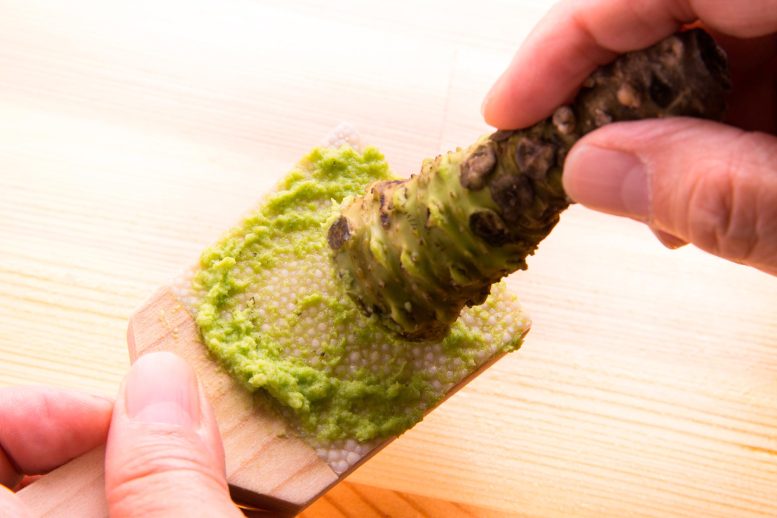
Wasabi is an essential element of sushi, but many sushi lovers have not experienced real wasabi. Even in upscale restaurants, a European horseradish-based substitute is often served.
Sushi wouldn’t be the same without wasabi. But odds are that even if you have dined at a nice sushi restaurant, you probably haven’t had real wasabi. That green paste may have a very real, very spicy kick, but it likely is made from a European horseradish. Speaking of Chemistry compares the real deal with the commonly used substitute found in most sushi restaurants, and explains the chemistry behind wasabi’s burn.
Unless you’ve had a sushi chef grate a $50 wasabi stem right onto your plate, you’ve probably not had the real thing. Find out what that green paste next to your tuna roll really is and how compounds in authentic wasabi may one-day treat a variety of medical ailments.
Video Transcript
If you’ve ever eaten at a sushi restaurant then you’ve probably tasted that green spicy paste people like to call wasabi. Truth is, you’ve probably never tried real wasabi.
You slip a sushi roll into your mouth. Beneath the raw fish, rice, and seaweed flavors you detect the hint of something spicy, like horseradish, rising up into your nose. Suddenly your sinuses are the clearest they’ve ever been in your life, and a prickling rush of heat moves up your neck, into your head, which starts thudding—possibly pleasantly.
You overdid it with the wasabi. Only, it’s probably not wasabi. That is, unless you’re actually in Japan, or imported the valuable plant at a hefty price, or found one of the few growers outside Japan.
The wasabi most of us have eaten is a mix of European horseradish, hot mustard, and green dye to give it the pistachio-colored hue of the Real McCoy.
Even in Japan, only a minority of restaurants serve real thing.
That’s because true Japanese wasabi is extremely tricky to cultivate. Wasabi likes to be lovingly enveloped in a steady stream of water, reminiscent of the rocky Japanese mountain stream beds where the plant grows endemically. And wasabi is not a fan of crowds. When planted en masse in a greenhouse, the plant can easily succumb to infectious disease.
Wasabi’s diva-like persuasion makes it a finicky crop, but also an extremely lucrative one. Case in point: Here in Berlin, you can import a 100-gram wasabi stem for 45 Euros—that’s about 50 bucks (US).
And listen. If you’re going to fork out this kind of cash for some wasabi, do not embarrass yourself and call it a root—it’s called a rhizome. In fact, the part of the wasabi plant that gets grated or pulverized into a paste is the above-ground stem component of the rhizome. You can see here where the leaves have either fallen or been cut off.
But how does this wasabi compare to its common substitute horseradish? Both get their spicy zing from a family of compounds called isothiocyanates—although wasabi typically contains more of the spicy chemicals than horseradish.
These isothiocyanates are kept on a chemical leash—they are attached to sugar molecules. When wasabi cells are pulverized during grating, they release enzymes that split apart the spice from the sugar, giving wasabi a zing with a hint of sweetness.
The dominant flavor—what foodies would call the top note—in both comes from a chemical called allyl isothiocyanate. The main flavor differences in wasabi and horseradish come from different relative proportions of other isothiocyanates. For example, wasabi has more 6-Methylsulfinylhexyl isothiocyanate, a-k-a 6-MITC, for obvious reasons.
Foodies aren’t the only folks interested in wasabi’s spicy chemicals. Medical researchers have their eye on 6-MITC, because some claim it can alleviate symptoms in a wide variety of disorders including asthma, cancer, and neurodegenerative diseases.
But for anyone with an appetite for pleasurable pain: try real wasabi.
Find a restaurant that starts grating the wasabi only after you’ve placed your order, or lets you grate your own wasabi, ideally with a traditional shark skin tool called oroshigane. That’s the only way you’ll get the full kick.
Wasabi flavors start floating away as soon as they’re released. Within about 15 minutes, the taste apocalypse you were hoping for is barely a spicy boot to the head.
And if you’re a glutton for spice, be sure to check out the description for the articles that inspired this episode and check out this video on sriracha sauce from our friends at ACS Reactions.









Be the first to comment on "Real vs. Fake Wasabi: The Surprising Truth on Your Sushi Plate"